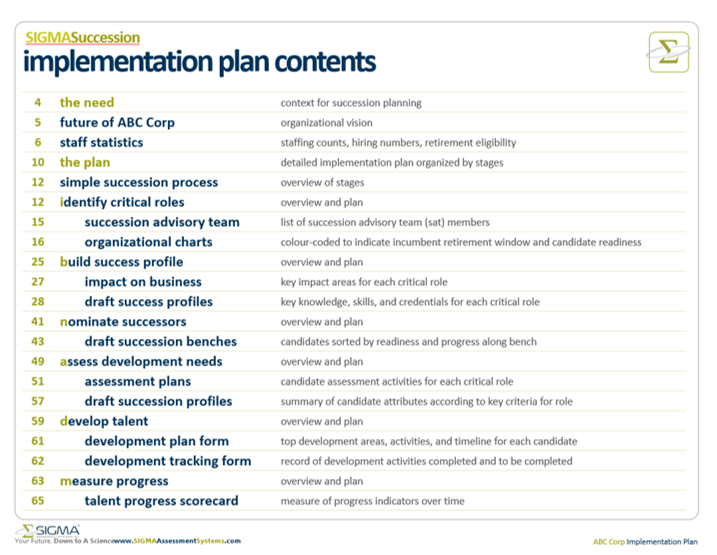How To Develop A Succession Implementation Plan
Developing a Succession Implementation Plan
Succession planning is vital to the prosperity and longevity of your organization. A good succession plan will allow your company to train and develop leaders during their tenure with the organization, so when a senior-level role becomes vacant, a new leader is already prepared to fill the critical position.
Your organization’s Implementation Plan is your roadmap to succession planning. It should outline the reasons why succession planning is important to your company and detail how you plan to move forward. An implementation plan for succession is a high-level guide that includes milestones, clearly defined responsibilities, and built-in progress checks. Below, we outline the essential components to create a successful Succession Implementation Plan.

Step 1: Establish the Need for Succession Planning
The first item in an Implementation Plan should be a strong business case for why succession planning is important. The goal in this section is to set the context for succession planning within your organization, and to gain buy-in from important leaders and stakeholders. This step in the succession implementation plan should be personalized to both your industry and your organization to be as relevant and compelling as possible.
One of the main goals of succession planning is to prepare your organization for the future, so remember to think long-term.
- What are some of the changes occurring in your industry?
- What are the challenges you expect your organization to face in the future?
- What kind of growth would you like to see in your company?
Tie in organizational strategic planning, industry trends, and market research to create a realistic overview of the future for your organization. Keep this in mind while executing your succession plan.
Where possible, this is also the place to use organization-specific statistics on turnover, retirement, and promotion to drive home the business case for succession planning.
- What proportion of your workforce is eligible to retire this year?
- In the next three years?
- In the next five years?
- Are employees in certain departments or positions leaving the company at different rates?
- Is your rate of hiring and promoting consistent with your rate of exits?
Presenting these numbers can go a long way in setting the stage for the need for succession planning.
“70% of succession plans fail within two years, because they lose management support”[1]
Step 2: Develop the Implementation Plan for Succession
Once your senior management team has reviewed and considered the need for succession planning, it is time to outline the way forward. The second, most substantial item of the Implementation Plan is the step-by-step outline of your succession plan. Use this section to detail how you will introduce succession planning to your organization, what form it will take, and how you will measure the success of your succession plan.
Begin with a high-level overview of the succession planning process. Although succession planning is simple in theory, any long-term plan can be difficult to conceptualize, and you will better retain the attention of your audience if they have a sense of what to expect. Use this summary page and the accompanying resources discussed below as a reference tool when you are in the midst of implementing your own succession plan.
Identifying Critical Roles for Succession Planning
The first practical step in conducting a succession plan is to identify the critical roles you need to plan for. Ideally, an organization would have a succession plan in place for every role, but this is often unrealistic. Instead, focus your plan to those high-impact, critical roles that would affect the stability and continuity of your business if the role were to become vacant. Plan to spend some time carefully choosing your succession advisory team. This team will work together to take responsibility for, implement, and evaluate the succession plan. Include your company’s organizational charts in your Implementation Plan, and use this as a chance to review them for areas in need of immediate attention. For more assistance on how to identify critical roles check out our helpful Critical Roles Identification Questionnaire worksheet to facilitate the process.
Evaluate Critical Roles for Succession
Once you and your succession advisory team have identified the the key positions for succession planning, the next step is to better understand these critical roles. This often-overlooked component is essential to ensure you are effectively training succession candidates to be successful in the future. Plan to evaluate the impact a given role has on the overall business, including how the focal duties are essential for success and how this role interacts with other important roles. Next, provide space for your team to build a success profile that clearly outlines:
- knowledge
- skills
- abilities
- characteristics
When creating your succession implementation plan, consider which research-validated assessments your company will use to maintain an objective perspective. Learn more about building success profiles for critical roles and check out our Success Profiles template.
Nominating Successors for Succession Implementation
The next phase of the Implementation Plan is nominating successors. Build time in your succession plan for leaders to create a succession bench of potential candidates for a role in their department, sorted by retirement eligibility and readiness for the role. For guidance on how to build your succession bench check out our sample template bench worksheet.
Further, plan to gather the entire succession advisory team and review department benches as a group. Your Plan should allow time for the team to work together to nominate the best succession candidates to prioritize for each role.
Assessing Development Needs for a Succession Implementation Plan
Assessing development need is the final stage of the preparation phase of an Implementation Plan. In this stage, you will plan how to measure current succession candidate
Many organizations rate less than 10% of their employees as high-potentials[2]
At this stage, your team will have outlined how to choose critical roles, determined a process for understanding these roles, created a plan to nominate succession candidates, and decided on the assessments to evaluate succession candidates. Now, the hard work of developing talent begins. Your plan should dedicate considerable time to this phase. For each candidate, build time to create an Individual Development Plan, and conduct one-on-one coaching to set goals, engage in opportunities to grow skills, and assess progress over time. Consider that your organization will need a variety of activities and opportunities for candidates to learn new skills, and leaders must be prepared to hold candidates accountable for their own growth. For a template of planning and tracking activities, see our Development Activities Worksheet. For more information on developing talent in your succession plan, read our blog post here.
The final stage of any good Implementation Plan is to measure progress. This step assesses the overall benefits of your succession plan, and should be conducted at least annually. Add tools like our Talent Progress Scorecard into your Implementation Plan to track important metrics specific to your company, such as high potential turnover and average years until a candidate is ready for their future role. This step will allow you to assess the success of your Plan to date, and to reassess and improve your Plan for the years to follow. To learn more on measuring the progress of your succession plan, click here.
Develop an Implementation Plan with SIGMA Succession Planning Consultants
Succession planning should be a tool that helps your organization remain not only viable, but successful in the long run. It should not be a burden or an overwhelming prospect. When it comes to implementing succession planning in your organization, SIGMA can help. Our Succession Process will guide you through each of the above phases of a succession planning process, and can assist you in creating success profiles, administering assessments, providing leadership coaching, evaluating your program success, and more.
Our Succession Planning Launch Series is designed to introduce your senior management team to succession planning, and in just two half-day workshops, deliver a personalized Implementation Plan for your organization. We also offer long-term consulting and project management for your personal Implementation Plan. Discover our Succession Planning solutions and ask us how we can help your organization develop your next generation of talent.
[1] Human Capital Institute as cited in Clutterbuck, D. (2012). The talent wave: Why succession planning fails and what to do about it. London, UK: Kogan Page.
[2]Corporate Executive Board Company (2014). Succession strategies for the new work environment [PDF]. Retreived from http://www.assessmentanalytics.com/wp-content/uploads/2014/12/CEB-Succession-Planning-Presentation-Deck.pdf
Related Posts

Evaluate the Impact of Succession Planning
November 2019

What Is Succession Planning?
June 2019